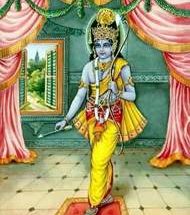Panchopachar Pooja
Home Pooja Vidhanam
This post will give you following:
- Short simple steps for quick pooja, approved as per scriptures.
- The mantras associated with steps. Though it can be done without mantras too.
- Meaning of these steps and why these are done
As devout Hindus, how dearly we all want to do daily pooja. If not possible at same time,then at least once in a day. But some of us either too lazy to carve out time and few other lack will or still some other question the necessity for this. Daily pooja ritual is termed as ‘Nitya Pooja vidhanam’ in Sanskrit and as ‘Dainik Pooja Vidhi’ in Hindi.
Being working professional maintaining daily routine of elaborate pooja will be very difficult for most of us. Its not only the length of pooja, at times people might not be in the right frame of mind to carry our elaborate procedure. ,A short simple pooja will keep the routine intact and obviate the guilt of skipping pooja. Some may llok out for shortcut pooja but it is absolutely possible to do a short but complete pooja.
Panchopachar Pooja is the answer for quick simple and effective pooja if you manage to spend just couple of minutes for Lord.
There are various kind of poojas. All these are done as per requirement of the occasion. these Poojas are mentioned as follows:
- Panchopachara puja (5 Steps Pooja): We are explaining it below here. This is short but complete pooja.Or This can be called a ‘Saral Pooja’ in Hindi.
- Shodashopachara puja (16 steps Pooja): This is used most of the time in formal settings like Diwali pooja etc. However more devout people do it everyday.
- Dwa-trisamsat upachara pooja (32 steps Pooja): This is very big pooja where elaborate steps are performed by learned Brahmans who know Karmakanda.
- Ekopachara pooja : This just means a prayer with manasik (mental) pooja.
However in elaborate Tantrik texts you will also find 64 steps pooja but we are not getting into that right now for the sake of simplicity.
Panchopachara is made by combinations of two Sanskrit words: Panch=Five, Upachara=Treatment. Pooja is a process of inviting God and offering him our best hospitality and respect as per best capability.
When some guest come to our home we offer him water to wash their feet, then we make arrangement for the to take bath, provide clothes and then offer sumptuous meal.
Similarly a standard 16 step Shodashopachar pooja has covers all steps from offering seat to offering Arati and Pradakshina (Cirumbulation).
However in Panchopachar we include only 5 main steps.
- Sugandh (By variation some people put Akshata in this step)
- Pushpam
- Dhoopam
- Deepam
- Naivedya
Simple steps of Shortcut Pooja: We have elaborated each step below in detail with mantras. However if you do not remember mantras just say ” Samarpayami” after each offering with full devotion to your deity. ‘Samarpayami’ is a sanskrit word which means” I offer you”. Your phrases will be like:
- Sugandham/Akshatam ….Samarpayami
- Pushpam ….Samarpayami
- Dhoopam ….Samarpayami
- Deepam ….Samarpayami
- Naivedyam ….Samarpayami
This is extremely short-cut or ‘Sankshipt’ pooja. It saves your time when you are in hurry. As maintaining regularity is important as well. If if you are short of time at least do this much.

Simple Panchopachar Pooja Procedure (Saral Panchopachar Pooja Vidhi):
Each of the steps of Panchopachaar Pooja Vidhi are given below with Mantras:
First recite the Dhyan Mantra mentally imagining the form of Lord. We have given below the Dhyan Mantra for Lord Krishna below:
Dhyana Mantra:
नमोस्त्व अनंताय सहस्त्र मूर्तये, सहस्त्रपादाक्षि शिरोरु बाहवे। सहस्त्र नाम्ने पुरुषाय शाश्वते, सहस्त्रकोटि युग धारिणे नम:।।
Namostva anantay sahastr murtaye sahastr padakshi shirorubahave | Sahastr namne purushay shashvate sahastr koti yug dharine namah||
Meaning: This is referring to the Vishwaroop from of Lord Vishnu, which was also shown by Lord Krishna to Arjun in Mahabharata) I bow down to the infinite, who has thousands of forms, who has thousands of legs, eyes, heads and hands| The one who is known by thousands of names , has always been and who propels thousands and crores of yugas.
(Step-1) Sugandham / Akshatam
(i)Sugandham (Sandal ):
ॐ श्रीखण्डम चंदनं दिव्यम गंधाढ़्यं सुमनोहरम्। विलेपनम सुर श्रेष्ठ चंदनं प्रति गृह्यताम्॥
Om Shrikhand-Chandanam Divyam Gandhadhyam Sumanoharam | Vilepan Shri Krishna Chandanam Pratigrihayantaam ||
Meaning: O Lord, this sandal is enamoured with great fragrance and is pleasant to have, Sandal is like a part of Lakshmi herself. Please accept this sandalpaset as tilak.
Apply Sandal paste on Lord’s forehead, on both earlobes, arms and both of his palms.
Alternatively you could use Akshat
(ii.) Akshatam (Unbroken Rice grains):
अक्षताश्च सुरश्रेष्ठ कुंकुमाक्ता: सुशोभिता:| मया निवेदिता भक्त्या गृहाण परमेश्वर || Akshatashch surashreshth kumkumaaktah sushobhitah| Maya nivedita bhaktya grihaan Parameshwar||
Meaning: This Akshat(unbroken rice grains) are mixed with red kumkum. Please accept it.
Note: Akshat is also used in case of absence of any other item, so the importance of Akshat is very high.
(Step-2) Pushpam( Flower) :
माल्यादीनि सुगन्धीनि मालत्यादीनि भक्तित:। मय आर्ह्यतानि पुष्पाणि पूजार्थम प्रति गृह्यताम्॥ Maalyaadini sugandheeni maalatyadeeni bhaktitah| May aarhyatani pushpani poojartham prati grihyataam||
Meaning: This garland of flower gives great fragrance and is symbol of my devotion. Please accept my this offering.
(Step-3) Dhoopam (Incense):
वनस्पतिरसोदभूतो गन्धाढ्यो गन्ध उत्तम:।आघ्रेय: सर्वदेवानाम धूपोअयम प्रति गृह्यताम्॥ Vanaspati Rasod Bhooto Gandhaadhyo Gandh Uttamah | Aaghreyah Sarv Devaanaam Dhoopodhyam Pratigrihayantaam ||
Meaning: This Incense is produced from the juice of plants and is fragrant. May this fragrance be felt by al Devas.
Light Incense, rotate it couple of times in front of Lord and place it in incense stand.
(Step-4) Deepam (Lamp)
साज्यं च वर्ति संयुक्तम वाहिन्ना योजितम मया। दीपम गृहाण देवेशि त्रैलोक्य तिमिरापहम्॥ Saajyam cha varti sanyuktam vaahinna yojitam maya| Deepam grihaan deveshi trailoky timirapaham||
Meaning: This beautiful lamp is lit with the burning vick and remover of darkness from all tree realms. Please accept this lamp.
Light up Lamp and rotate it couple of times in front of Lord and place it on one side.
(Step-5) Naivedyam (Fruits etc):
इदम फ़लम मया देवम् स्थापितम पुरतस्तव। तेन मे सफ़ल अवाप्तिर भवेज जन्मनि जन्मनि॥
Idam Falam Mayaa Dev Sthapit Pur-Tastav | Ten Me Safalaanitti Bharavejanmani Janmani ||
Meaning: Dear Lord, Please accept these fruits as my offerings
Meaning of 5 Steps in Panchopachar Pooja:
- Sugandh: Offering the Sandal is the representation of Erath element. Lam is the beej mantra of Earth Element. In our astral body the Earth element is represented by Mooladhara Chakra.
- Pushpam: Offering Pusham is symbol or Akash or Sky element. Ham is the beej mantra of Akasha element. In our astral body Akash element is represented by Vishuddha Chakra.
- Dhoopam : Dhoopam repersents the Air element. ‘Yam’ is the beej mantra/seed letter for Air. Air element is represented by Anahat Chakra situated behind heart in our astral body..
- Deepam: Deepam repersents the Fire element. ‘Ram’ is the beej mantra/seed letter for Fire. Fire element is represented by Manipurak Chakra situated behind navel in our astral body..
- Naivedya : Naivedya represents the Water element. ‘Vam’ is the beej mantra/seed letter of water. We offer the Naivdeya as Rasa to deity, this is symbolic of nectar. Water element is represented by Swadhishthan Chakra in our body.
Thus with pachopachara Pooja you connect with the five elements with the Grace of Lord. Alos, when you meditate on Lord’s image in your mind , that is activation of Ajna Chakra. Beej Mantra for Ajna Chakra is Om.
In short by pooja not only you are propitiating your Ishta deity you are also receiving his/her grace, as your chakras are getting activated by the pooja. Over a period of time regular pooja cleanses your chakras and consequently your thoughts and your conduct in the long run.
Having said all above, the most important ingredient of any Pooja is UNCONDITIONAL DEVOTION to your Ishta Deity only. Without devotion nothing renders full results.
Panchopachara Pooja FAQs
Q1.What is Panchopachara Pooja?
A. Panchopachar Pooja is a simple form of worship wherein we worship God with five article in five steps. These steps are 1.Sandal Fragrance/Akashata-Unbroken rice, 2. Flowers, 3. Incense ,4. Deepam-Lamp lighting, 5. Naivedyam-Fruits edibles.
Q2.Who can do Panchopachara Pooja?
A. Anyone perform Panchopachara Pooja irrespective of caste and creed.
Q3. Can Menstruating women do Panchopachara Pooja?
A. No menstruating women should be rested and should not perform any kind of physical form of pooja however they can still do Ekopchar pooja/Masnik-Mental pooja which can be done mentally and has great merits as well.
Q3. Can a person do Panchopachara Pooja without bath?
A. No you should not offer any physical pooja in unclean state. But you can still do mental-mansik pooja but chant ‘Pavitrikaran mantra‘ first before that as well. It could be handy when you are unwell and are not in a position to take bath.
Dibhu.com is committed for quality content on Hinduism and Divya Bhumi Bharat. If you like our efforts please continue visiting and supporting us more often.😀
Tip us if you find our content helpful,
Companies, individuals, and direct publishers can place their ads here at reasonable rates for months, quarters, or years.contact-bizpalventures@gmail.com




Very and systematic Pooja procedures are narrated. This is a useful for common peoples.
Pranam! Bahut Bahut Dhanyawad aapaka protsahan ke liye!